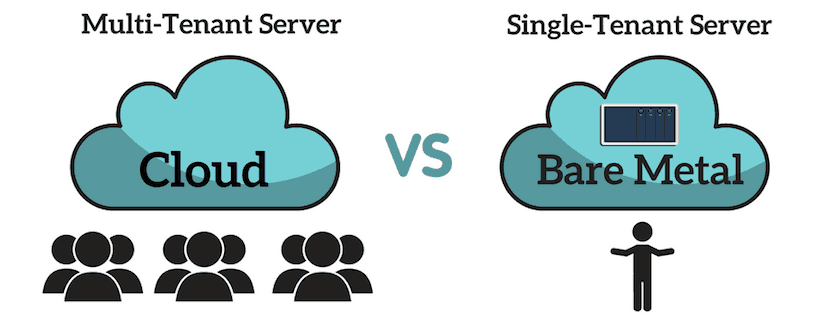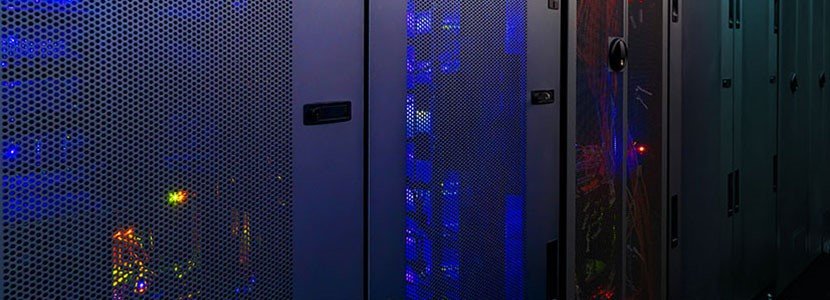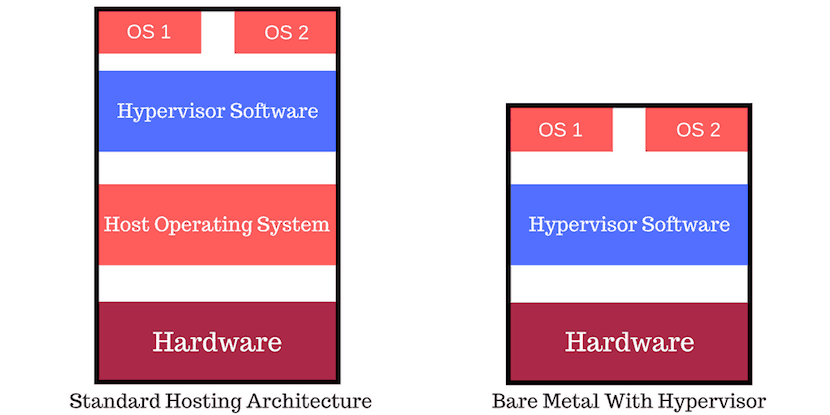Are you looking for a highly scalable, flexible and fast solution for your IT backbone?
Understanding the difference between bare metal or virtualized environments will allow you to make an informed decision.
Take the time here to master the basics:
What are the requirements for your project regarding performance, density, and compliance? These terms will determine your deployment strategy, including the ability to run virtualized environments.
What is Bare Metal?
Bare Metal is just another way of saying “Dedicated Server.”
This is a single tenant environment with direct access to underlying hardware technology without any hypervisor overhead. Bare metal can support many kinds of operating systems on top of its core performance.
The term bare metal refers to direct access to the hardware. This would only emulate that environment through virtualization. This would only emulate that environment through virtualization.
What is a Bare Metal Hypervisor?
A bare metal hypervisor or a Type 1 hypervisor, is virtualization software that is installed on hardware directly.
At its core, the hypervisor is the host or operating system.
It is structured to allow for the virtualization of underlying hardware components to function as if they have direct access to the hardware. The hypervisor allows a computer’s operating system to be separated from the core hardware and physical structure. It allows multiple clients to be housed on the same computer. Server Virtualization allows for a much denser deployment at the cost of the overhead and limited ability to leverage all hardware features.
Each client will experience a simulation of its own dedicated server. The physical resources such as memory, CPU cycles and bandwidth of the server are shared by all tenants. Hypervisors can be used to make better use of the hardware, particularly in cases where all resources are not being utilized. Virtualization does not need an OS to function, but it could. Datacenters look at hypervisors deployed on top of bare metal servers and not within the OS. Datacenters look at hypervisors being deployed on top of bare metal servers and not within the OS.
The type of image that a virtual environment creates also determines the performance of a hypervisor.
Microsoft, Citrix, and VMware have the three most popular hypervisor systems. The Hyper-V, Systems XenServer and ESX brands, respectively, represent the majority of the hypervisor market today.
Who is Bare Metal Ideal For?
The bare metal environment works well for many types of workloads regardless of company size.
Enterprise data centers require granular resource and access management, high level of security, and ability to scale. Single tenant environments can perform better and do not run into the risk of “noisy neighbors.” There is less risk involved from a security perspective due to physical isolation.
What are the Major Features of Bare Metal?
Bare metal servers are dedicated to one client and are never physically shared with more than one customer. Bare metal is often the most efficient way to manage resources. Bare metal is often the most streamlined way to command resources.
With bare metal, clients can avoid what is known as the “noisy neighbor effect” that is present in the hypervisor environment. These servers can also run equally well in individually owned data centers or co-location, held by IT service providers/IaaS providers. A business also has the option to rent a bare metal server easily on a subscription from a managed service provider.
The primary advantage a bare metal environment is its separation. The system does not need to run inside of any other operating system. However, it still provides all of the services to the virtual environments that are necessary.
What Are The Benefits Of Bare Metal?
Without the use of bare metal, tenants receive isolation and security within the traditional hypervisor infrastructure. If a physical server becomes overloaded by requests or consumption of one tenant, isolation is a problem. The bare metal environment completely avoids this situation.

Bare metal also gives administrators the option to increase resources through the ability to add new hardware.
Lower overhead costs
– Virtualization platforms incur more overhead than bare metal because no hypervisor layer is taking the processing power of the server. The responsiveness of the solution and its overall speed will increase with less overhead. Bare metal also allows for more hardware customization, which can improve speed and responsiveness.
Cost effective for data transfer
– Bare metal providers often offer much more cost-effective approaches to outbound data transfer. Dedicated server environments may offer several terabytes free data transfer. Virtualized environments, if everything else is equal, would not be in a position to match the initial offers. However, these scenarios are dependant upon server offers and partnerships and never guaranteed.
Flexible deployment
– Server configurations can be incredibly precise. Depending on your workload, you may be able to mix bare metal and virtual environments.
QoS
– Quality of Service often work to eliminate the problem of the “noisy neighbor” occur in the bare metal environment. This is a great financial and technical advantage. As with any SLA, this may vary from case to case. However, as with any SLA, this may vary on a case-by-case basis.
Greater security
– Organizations that are very security sensitive may worry about falling short of regulatory compliance standards in a hypervisor multitenant environment. Some companies hesitate to switch to cloud computing based on bare metal servers. It is possible to separate resources completely using bare metal servers. Virtualization doesn’t mean that security is compromised. Security is incredibly complex and broad terminology, and there are many factors involved.
What Are The Benefits Of Bare Metal Hypervisors?
You may not need the elite performance of a single tenant, a bare metal server. Hypervisors can help your company better use resources. Hypervisors have many benefits, even when compared to the highly efficient and scalable bare-metal solution. Choose a hypervisor when you have a dynamic workload, and you do not need to have an absolute cutting edge performance. Workloads that need to be spun up and run for only a short period before they are turned off are perfect for this environment.

Backup and protection
– Virtual machines are much easier to secure than traditional applications. It is necessary to pause an application before it can be backed-up. This is a very lengthy process that can cause the application to be down for a considerable amount of time. Snapshots can easily and quickly capture the memory of a virtual machine. The snapshot can be stored on a disk within seconds. Every snapshot that is taken can be recalled, providing recovery and restoration of lost or damaged data to a user on demand.
Improved hardware utilization
– A bare metal server may only play host to a single application and operating system. Hypervisors use more network resources to host multiple VMs. Each of these instances can run an entirely independent application and operating system on the same physical system.
Improved mobility
– The structure of the VM makes it very mobile because it is an independent entity separate from the underlying hardware. A VM may be migrated to any local or remote virtual server that has enough resources. It can be done at any time without causing any disruption. It happens so frequently that the term “live migration” has become a popular buzzword. Containerization is the key to ultimate mobility. Ultimate mobility is achieved with containerization.
Adequate security
– Virtual instances created by a hypervisor are isolated logically from each other, even if they are not separated physically. They may share the same server physically, but they don’t have any basic knowledge about each other. The problem is not transferred to the other server if one is attacked, or if there’s a mistake. Although the noisy neighbor effect may occur, hypervisors are incredibly secure although they are not physically dedicated to a single client.
Making the Best Decision for Your Project
Every situation is different, and each requires looking at all solutions available. There is no definitive answer to the question of whether a bare-metal server running native workloads or bare-metal with a virtualized workload is better. Once evaluated, decisions are made based on what you and your team feel most comfortable with, and what fits your needs. Testing both systems is recommended to validate performance as well as how it impacts your infrastructure and your service management.
With the proper understanding of security, scalability, and flexibility, you should be primed with enough tools to narrow down your decision. A bare-metal type 1 hypervisor may be the answer your business is looking for.

